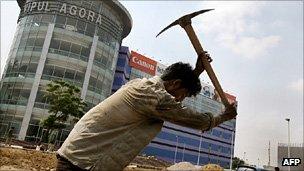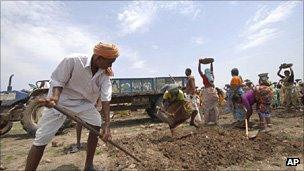Is India in the throes of 'distress migration'?
- Published
- comments

Millions of villagers are migrating to cities in search of work
Are millions of Indians being forced to leave their villages for cities and towns because there aren't enough jobs at home and farm incomes are drying up? Is this "distress migration" unprecedented in India's history?
Award-winning journalist P Sainath, external thinks so. Examining the latest census data, he finds that India's urban population has risen more (91 million more than in the 2001 census) than the rural population (90.6 million more than in the 2001 census). Nearly half the people in states like Tamil Nadu already live in urban settlements.
The last time, writes Mr Sainath, the rise in India's urban population exceeded the rise of the rural population was 90 years ago and reflected in the 1921 census. The decline in rural population then could be possibly linked to the 1918 flu pandemic, external that killed several million people.
This time around, Mr Sainath says, the increase in migration is driven by the "collapse of millions of livelihoods, external in agriculture and its related occupations". He writes that massive migrations "have gone hand-in-hand with a deepening agrarian crisis, external": more than 240,000 farmers, mostly broken by debt, committed suicide, external in India between 1995 and 2009.
'Despair-driven'
Mr Sainath has spent a lifetime reporting on distressed farmers and how the poor live in India. He admits that the census is not equipped to examine the complexity of migration in India. In a fast urbanising country, rising migration from villages to cities and towns is natural. Also, newer "urban areas" are being added all the time. The big picture is also not strikingly unusual. According to the census, 31.16% of Indians live in urban areas, up from 27.81% in 2001 - a rate which is actually significantly lower than the rate in many developing countries with similar income levels.
But, argues Mr Sainath, these "natural" factors which triggered migration from villages to cities have been valid in the earlier decades too when additions to the village population actually outstripped those to the cities. So why is the last decade throwing up a radically different result?

Many say the jobs for work programme has checked migration
Mr Sainath believes that millions of Indians are trapped in "footloose" migrations - the poor drifting from place to place "without a clear final destination". He talks about a "despair-driven exodus" in the countryside.
Many economists believe that it may be a little too early to conclude that the rising migration from villages to cities is being triggered by economic distress at home.
For one, they point to the fact that 90% of the increase in urban settlements - 7935 in 2011, up from 5161 in 2001 - is from the rise in the number of new "census towns". A settlement is declared such a town when its population exceeds 5,000; when the number of male farm workers falls to less than 25% of the total; and where population density is at least 4,000 people per sq km. "It is also likely that a very significant part of the 'urbanisation' that is being talked about is actually a reflection of this reclassification, external of settlements rather than of rural to urban migration," says renowned economist Jayati Ghosh, external.
Many economists believe that India's landmark multi-billion dollar jobs guarantee scheme, external scheme has checked migration of workers from villages to cities. Thanks to guaranteed wages and days of work, many villagers prefer to stay back and work. Others believe that India's big cities are becoming more and more uninviting to rural migrants: they are offered very few and appalling amenities, including housing and sanitation, have to pay bribes even for a basic vending business, and cough up steep rents. All this should slow down the rate of migration from rural to urban areas, economists like Amitabh Kundu, external of Jawaharlal Nehru University say.
There may be other pressing questions to ponder. How does India cope with its increasing urban population? Its cities are choking under power cuts, scarcity of water and polluted air. Also the increase of new urban settlements with poor amenities and limited access to jobs could easily lead to massive social unrest among the migrants in the new "cities". Which could actually end up wrecking India's cities faster than its villages.